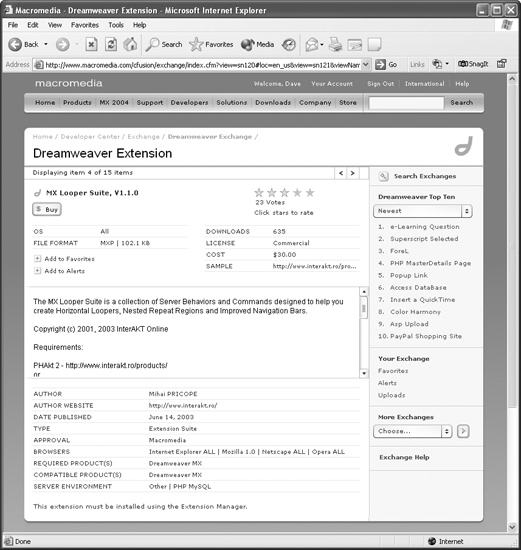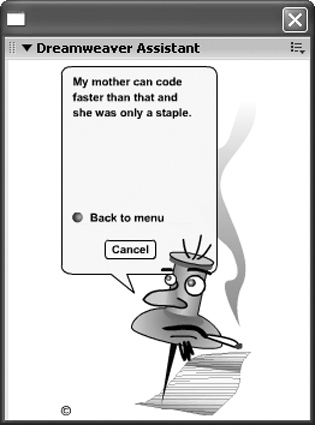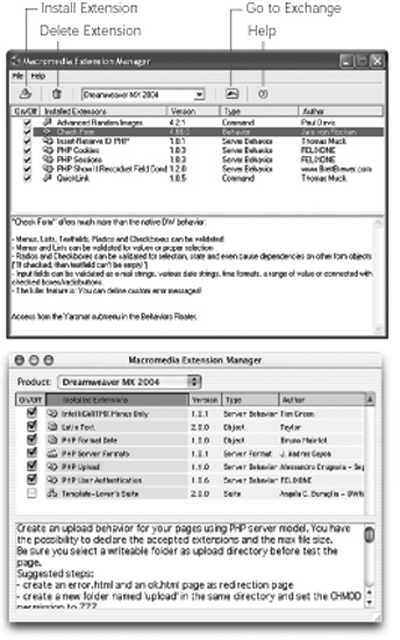|
|
< Day Day Up > |
|
20.2 Dreamweaver ExtensionsWhile keyboard shortcuts provide an easy way to access frequently used commands, they're not much help if the command you want doesn't exist. Suppose, for example, that you use the Validate Form behavior to make sure visitors to your site properly fill out your forms (see Section 19.3.5). However, you wish that in addition to just checking for an email address or number, that it could check for phone numbers, Zip codes, and social security numbers. What's a Web designer to do? You could dash off a quick email to wish-dreamweaver@macromedia.com , asking the bustling team of programmers to add the command to the next version. But you'd have to wait (and there's no guarantee that Macromedia will do it). The legions of hard-core Dreamweaver fans have taken this feature wish-list issue into their own hands. As it turns out, amateur (and pro) programmers can enhance Dreamweaver relatively easily by writing new feature modules using the basic languages of the Web: HTML, JavaScript, and XML. (In fact, HTML forms, JavaScript programs, and XML documents constitute much of the program. The objects in the Insert bar, for example, are actually HTML pages stored within Dreamweaver's Configuration folder, and all of Dreamweaver's menus have actually been written as an XML file. ) Because of this "open architecture," you can add new functions and commands, called extensions, to Dreamweaver by downloading the work of all of those programmers. A Dreamweaver extension can take many forms and work in a variety of ways to change the way the program works. It can be an icon on the Insert bar, a behavior listed on the Behaviors panel, or a command in the Commands menu. It might even be an entirely new floating window, like the Property inspector, that you use to alter some aspect of your page. Best of all, whereas programming ability may be required to create extensions, none at all is necessary to use them. You can download hundreds of extensions from the Web and install them on your computer for free. In addition, many sophisticated extensions, like those for creating ecommerce sites, are commercially available. NOTE
Extensions have been around for many versions of Dreamweaver. Unfortunately, each version of Dreamweaver added a few kinks for extension developers, so not all extensions out there work with Dreamweaver MX 2004. (Many extensions that were compatible with Dreamweaver MX do work with MX 2004.) Most extension developers list which versions of Dreamweaver their extensions work with, and you can also check for version compatibility on the Dreamweaver Exchange (see Figure 20-2). 20.2.1 Browse the ExchangeThe largest collection of extensions waits at the Macromedia Exchange Web site. Here, you'll find hundreds of free and commercial extensions. Although some come from Macromedia itself, the vast majority are written by an army of talented Dreamweaver users. Using the Exchange is a straightforward process.
Each extension has its own page in Macromedia Exchange that provides information about the extension and its developer. A helpful voting mechanism (1 - 5 stars) lets you know what other people think of the extension.
20.2.2 Find a Good ExtensionHow do you figure out which extensions are worth checking out? First, you can find some recommendations of the best ones scattered through this book in special sidebars labeled Extension Alert (see Section 11.4 and Section 13.1.2.4, for example). The Exchange also provides information to help you separate the wheat from the chaff. Macromedia tests each new extension before posting it. Extensions that pass a basic set of tests梚t installs OK, it works, it doesn't blow up your computer梐re given a Basic approval rating. Some extensions also pass a more rigorous test that determines if the extension works in a way that's "Dreamweaver-like." In other words, these extensions are designed to look, feel, and act like the program, so that you won't need to learn a new interface. These extensions get a Macromedia Approved rating, indicated by the word Macromedia in the approval section of an extension's details page. Of course, these approval ratings only let you know if an extension works; they don't tell you that it's useful. As an extra aid, Dreamweaver aficionados (including you) can rate each extension on a scale of 1 (worst) to 5 (best). An extension's average rating gives you a good indication of how handy it is. When you're browsing the Exchange, look for the column labeled with a star to the right (see Figure 20-2). Click the header to organize the extensions from most- to least-recommended. If you ever need some destructive criticism, download the Dreamweaver Assistant extension. The "assistant," a cigarette-smoking pushpin with a goatee and an attitude (and a stinging spoof of Clippy the Moronic Paper Clip in Microsoft Office for Windows), will gently comment on your site, ask for a beer, and make time with a paper clip. You'll find this amusing waste of time in, ironically, the Productivity category of the Exchange.
20.2.3 Other Extension SourcesUnfortunately, the glory days of totally free extensions are over. You can still find plenty of extensions offered free of charge, but many developers have realized they can't survive by giving away their work. The upside is that there are more excellent, polished, well-documented commercial extensions than ever梞any even with customer support. Here are a few highlights:
20.2.4 Download and Install ExtensionsOnce you've found a great extension, download it to your computer. You can save
the resulting downloaded file anywhere on your computer, but the Dreamweaver MX
2004 A downloaded extension file's name ends with .mxp, which stands for Macromedia Exchange Package. That's a special file format that works with the Extension Manager梩he program, described next, that actually installs the extension into Dreamweaver. 20.2.4.1 The Extension ManagerTo add and remove a Dreamweaver extension, you use the Extension Manager, a stand-alone program that's integrated with Dreamweaver. It's designed to manage extensions for many Macromedia programs (not just Dreamweaver): you can install extensions, turn them on and off, and remove them. This feature can be quite handy if you also use Macromedia's Flash or Director programs; you have a single access point for managing all your extensions. You can launch the Extension Manager from within Dreamweaver by choosing Commands To add an extension:
The Extension Manager window lists each extension you've installed along with its version number, type, and author. If you select an extension from the list, a description displays in the bottom half of the window. The Windows and Macintosh versions differ slightly: the Windows version (top) includes four buttons for easy access to common tasks; the same functions can be accessed on the Mac (bottom) from the File and Help menus.
To remove an extension, select it from the list and choose File
If you had downloaded and installed a bunch of extensions back when you used
Dreamweaver MX, you can import them into Dreamweaver MX 2004 by choosing
File 20.2.5 Make Your Own ExtensionsThe Exchange is a great resource for finding useful extensions. But what if you can't find the extension you need? Create your own. Writing extensions involves in-depth knowledge of JavaScript and HTML. But when you create a command that lets you complete a weekly task in a fraction of the time it took before, the effort may just be worth it. For more information, the Extensions menu available from the Help menu provides three electronic references that can help. The Macromedia Web site also offers help at the Dreamweaver support center: www.macromedia.com/support/dreamweaver/extend.html .
|
|
|
< Day Day Up > |
|